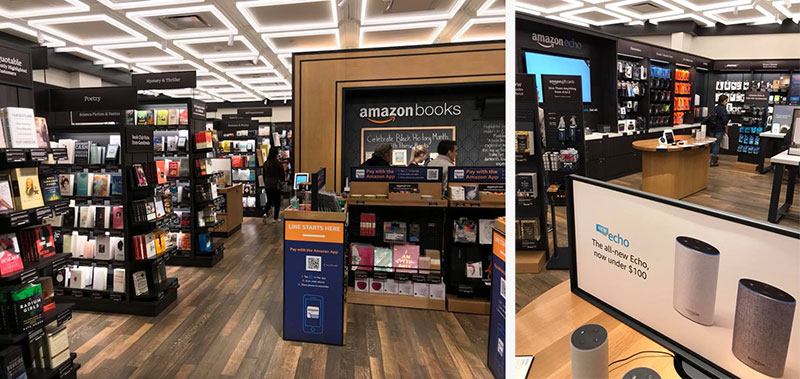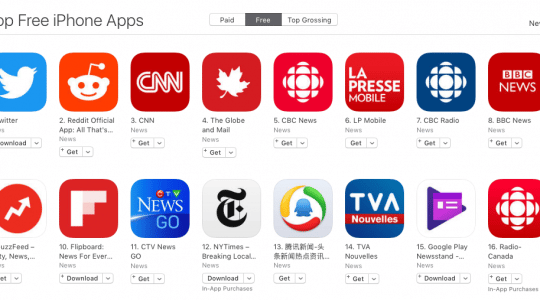
Mobile traffic is up. M-commerce is growing fast. Desktop conversions to sales are still strong. And yet, the lion’s share of all commerce happens on the street.
That means change is happening, sure.
But more critically, convergence is happening. And that’s a much bigger story about retail than any individual data point on mobile, desktop, or store.
This is part three of a five-part series on omnichannel customer engagement highlighted in our new e-book, “Taps, Clicks, Bricks: Omnichannel Customer Engagement Is the New Brand Superpower.” Download the full e-book for free here.
- Buying Is Changing: Hard Data
- Shopping Is Changing: The New Customer Journey
- The New Retail: Silicon Valley and Main Street Are Converging
- Playbooks: How Top Brands and Retailers Are Winning
- Getting Started: 5 Critical Components for Success
In the first part, we saw that retail mobile traffic is at 56% and growing. That m-commerce will hit $1.8 trillion globally in 2018. And that desktop commerce in the U.S. is still strong, accounting for 61% of all purchases.
But in the second part, it became clear that brand encounters are mostly mobile. That mobile is where consumers research products the most. And yet, that for complex purchases, people turn to their desktops, and most still prefer to shop at bricks-and-mortar stores.
This means the future of commerce is omnichannel.
Omnichannel In Action
Personally, this became obvious a couple months ago, in February 2018.
Coming off the ice after a hockey game, I discovered that my skate blade was cracked — broken in two, even. That was the first time that anyone on my team, including me, had seen that kind of equipment failure. And it meant I immediately needed a new pair of skates.
Mobile: After hearing the news, my wife checked her email on her smartphone, sure she had just seen a promotion from a sports store that we frequent. Jackpot! She found a 15% off coupon for online orders at Sport Chek, a local sporting goods store.
Desktop: Needing more screen real estate to evaluate skate options, I jumped on her iMac and found a high-quality pair from Bauer, a brand I’ve bought in the past. Last year’s model was an additional 40% off, which tipped the scales. My credit card got some exercise.
Delivery: Three days later, I had the skates at home. I put them on: instant pain. Either I’m a hobbit, or my feet had expanded. I needed the extra-wide size.
Phone/Call Center: I called Sport Chek and explained the issue. The call center employee found the exact same skates in a nearby store and reserved a pair for me.
Store: I visited the store, tried on the new skates (heaven on my feet!), and made the exchange. Then we did the heat-forming process, in which the skates are heated and form-fitted to the wearer’s feet. (It’s possible to do at home, but significantly more difficult.)
Five Touches, Four Media: In summation, we touched the brand five different ways, in four different “media,” including delivery and in-store, and twice on mobile. Alternatively, the brand touched us, making itself available — and top of mind — via both promotions (which are important) and availability (which is critical).
That’s omnichannel in action. A convergence of capability: seamless digital and in-store experiences.
Reverse Migration: Silicon Valley, Meet Main Street
E-commerce giants see the numbers and the trends. They know that if they want to access untouched trillions in retail revenue, they need a home on Main Street in addition to an icon on a smartphone or a bookmark in your browser.
(They also need your email address. And registered, signed-in experiences via apps and websites. And permission, perhaps, to push message customers via mobile. And on and on.)
Amazon is a key example of this migration to Main Street, and not only due to the acquisition of Whole Foods.

An Amazon Books location, featuring curated book selections and Amazon gadgets such as the Echo and Kindle, in New York, NY. Photo credit: Jeremiah Owyang. Used with permission.
The company has been experimenting in old-fashioned bricks-and-mortar retail for years. Amazon only recently started breaking out physical store revenue: $1.3 billion in Q3 2017, and a cool $4.5 billion in Q4, thanks to its new grocery subsidiary. The Amazon Books stores that it opened in malls have helped to sell the company’s tech goods, sure, but could also have been a response to the 6.1% increase in sales at physical bookstores in the first half of 2016.
[bctt tweet=”“Physical goes digital then back to physical: brick to click to brick,” says technology industry analyst Jeremiah Owyang.” username=”tune”]Apple and Microsoft started the tech company trend of opening physical stores, but now many e-commerce retailers are joining this reverse migration from the web (and mobile) to the street. These retailers are opening pick-up kiosks, try-before-you-buy storefronts for multiple brands — think b8ta — and full-on retail stores with design, product selection, and functionality informed by digital commerce.
Think Warby Parker, which was born online in 2010, and this year will have almost 100 physical stores. Or Bonobos, with 48 locations now.
Everlane (apparel), Casper (mattresses), and Untuckit (men’s shirts) are all following the be-everywhere playbook too, while more traditional brands like Sephora, Best Buy, Home Depot, and Walmart have made massive strides in extending physical locations with fully mobile- and web-optimized omnichannel strategies.
Given what we’ve seen from consumers — and will shortly share in this report — both online to offline and offline to online migrations are smart moves.
Taps, Clicks, Bricks
As I jumped on the ice for my next game in my new skates, it struck me: This was omnichannel in action.
From mobile, where my wife was connected to the retailer, to desktop, where it was easier to consummate a purchase, to call center, to actual physical store, Sport Chek was visible, active, engaged, and operating off the same dataset (as far as I could tell).
That’s convergence.

It’s been popular to assume that physical stores are white elephants: increasingly obsolete remnants of an earlier age. And it’s true that, for certain segments of the population, the combination of e-commerce and cheap, speedy delivery has been irresistible.
But the data suggests that’s not a massive slice of the population. And there’s evidence from hip young retailers like Warby Parker and b8ta that even these tough-to-reach customer segments are open to retail in a multitude of media.
Beyond Omnichannel: Customer Engagement
Omnichannel is about integrating the various ways consumers interact with and purchase from retailers and brands.
Omnichannel is good, but it’s not enough.
Without knowledge, brands can’t tailor customer experiences. Without data, retailers can’t make smart choices about consumer needs and desires. Without a logged-in experience, whether on the web, in an app, or — as is increasingly available — a known, personalized in-store experience, brands cannot effectively provide service or support.
[bctt tweet=”Knowing your customer is the new superpower. Engaging with your customer is the source of that power. And earning the logged-in experience is how you get it.” username=”tune”]
When your product or service is structured to provide substantive customer value for signing up and logging in, and when your brand promise is strong and trustworthy enough to warrant customers making the effort to do so, you’re in a position to know your customers.
Known customers have engaged with a brand, and engaged customers buy 90% more often. In fact, customers who sign in to their personal accounts on e-commerce sites “convert 10X more than average,” says Duncan Keene, the UK managing director for ContentSquare.
[bctt tweet=”And repeat customers spend twice as much as new customers.” username=”tune”]Therefore, brands that know their customers well enough to build strong relationships with them are more likely to be able to generate stable ongoing sales. They are then worth much more than brands with unknown customers who have to fight for existing as well as new market share every single month.
Ergo: Knowing your customer is the new omnichannel.
Brands Are Now Retailers Too
From house brands in the 1990s to Amazon Basics today, retailers have long been recognized as brands. And while some brands have tried multiple paths to market, we’re seeing an increasing trend for brands to sell direct to consumers in ways that would be been unthinkable in previous decades.
Under Armour sells direct to consumers on its website.
Nestle brands go direct to consumer via subscription commerce.
Apple has long sold straight to users, and Microsoft does as well. Google has followed suit over the past few years. When Gillette was threatened by direct-to-consumer competitors, the company launched the Gillette Shave Club. Olay is resistant, but has been testing the model with some products, and many other brands have followed suit.
The benefit?
Brands that know their customers’ names, shipping addresses, and credit card numbers are in much greater control of their financial destiny than brands that rely on shelf space and digital placement. In addition, they have a much greater opportunity to retain business and upsell to a greater wallet share with complementary products.
What’s the difference? Knowing your customer.
Next week, we’ll explore how massive brands and retailers like Citi, Home Depot, Walmart, OceanX, Unilever, ACI Worldwide, and eBay are taking these lessons and making them real.
. . .
. . .
To be continued next week: Playbooks: How Top Brands and Retailers Are Winning.
This is part three of a five-part series on omnichannel customer engagement highlighted in our new e-book, “Taps, Clicks, Bricks: Omnichannel Customer Engagement Is the New Brand Superpower.” Download the full e-book for free here.
Author
Before acting as a mobile economist for TUNE, John built the VB Insight research team at VentureBeat and managed teams creating software for partners like Intel and Disney. In addition, he led technical teams, built social sites and mobile apps, and consulted on mobile, social, and IoT. In 2014, he was named to Folio's top 100 of the media industry's "most innovative entrepreneurs and market shaker-uppers." John lives in British Columbia, Canada with his family, where he coaches baseball and hockey, though not at the same time.




Leave a Reply
You must be logged in to post a comment.